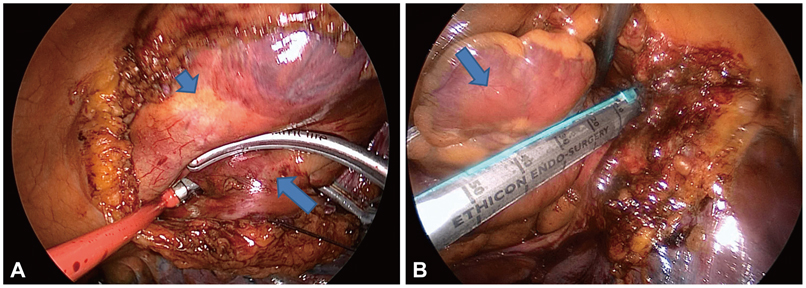Korean Circ J.
2013 Jun;43(6):422-425. 10.4070/kcj.2013.43.6.422.
A Hybrid Procedure for Atrial Fibrillation Using Total Thoracoscopic Ablation and Post-Procedural Electrophysiological Confirmation of Ablation Lines
- Affiliations
-
- 1Department of Thoracic and Cardiovascular Surgery, Samsung Medical Center, Sungkyunkwan University School of Medicine, Seoul, Korea.
- 2Division of Cardiology, Department of Internal Medicine, Samsung Medical Center, Sungkyunkwan University School of Medicine, Seoul, Korea. yk.on@samsung.com
- KMID: 2224905
- DOI: http://doi.org/10.4070/kcj.2013.43.6.422
Abstract
- Atrial fibrillation (AF) is the most common chronic arrhythmia in the world, and it is associated with an increased long-term risk of stroke, heart failure, and all-cause mortality. To overcome the limitations of transvenous radiofrequency (RF) ablation for AF, total thoracoscopic ablation (TTA) has evolved as a new technique. TTA has several advantages over transvenous RF ablation and is known to produce better outcomes, especially in patients with persistent AF. Herein, we report 2 cases of successful TTA followed by an electrophysiological study confirming satisfactory ablation lines; the first such procedure reported in Korea.
Keyword
MeSH Terms
Figure
Reference
-
1. Go AS, Hylek EM, Phillips KA, et al. Prevalence of diagnosed atrial fibrillation in adults: national implications for rhythm management and stroke prevention: the AnTicoagulation and Risk Factors in Atrial Fibrillation (ATRIA) Study. JAMA. 2001; 285:2370–2375.2. Stewart S, Hart CL, Hole DJ, McMurray JJ. A population-based study of the long-term risks associated with atrial fibrillation: 20-year followup of the Renfrew/Paisley study. Am J Med. 2002; 113:359–364.3. Wolf RK, Schneeberger EW, Osterday R, et al. Video-assisted bilateral pulmonary vein isolation and left atrial appendage exclusion for atrial fibrillation. J Thorac Cardiovasc Surg. 2005; 130:797–802.4. Sagbas E, Akpinar B, Sanisoglu I, et al. Video-assisted bilateral epicardial pulmonary vein isolation for the treatment of lone atrial fibrillation. Ann Thorac Surg. 2007; 83:1724–1730.5. Jansen WPJ, Wijffels MC, Wever EFD, van Boven WJ, Yilmaz A, Boersma LV. Recurrence of atrial fibrillation after mini-Maze is associated with pulmonary vein reconnection. Eur Heart J. 2009; 30:Suppl 1. 813.6. Edgerton JR, Jackman WM, Mack MJ. Minimally invasive pulmonary vein isolation and partial autonomic denervation for surgical treatment of atrial fibrillation. J Interv Card Electrophysiol. 2007; 20:89–93.7. McClelland JH, Duke D, Reddy R. Preliminary results of a limited thoracotomy: new approach to treat atrial fibrillation. J Cardiovasc Electrophysiol. 2007; 18:1289–1295.8. Edgerton JR, Edgerton ZJ, Weaver T, et al. Minimally invasive pulmonary vein isolation and partial autonomic denervation for surgical treatment of atrial fibrillation. Ann Thorac Surg. 2008; 86:35–38. discussion 39.9. Pappone C, Santinelli V, Manguso F, et al. Pulmonary vein denervation enhances long-term benefit after circumferential ablation for paroxysmal atrial fibrillation. Circulation. 2004; 109:327–334.10. Oh S, Zhang Y, Bibevski S, Marrouche NF, Natale A, Mazgalev TN. Vagal denervation and atrial fibrillation inducibility: epicardial fat pad ablation does not have long-term effects. Heart Rhythm. 2006; 3:701–708.11. Halperin JL, Hart RG. Atrial fibrillation and stroke: new ideas, persisting dilemmas. Stroke. 1988; 19:937–941.
- Full Text Links
- Actions
-
Cited
- CITED
-
- Close
- Share
- Similar articles
-
- Is a hybrid procedure the gold standard in patients with persistent atrial fibrillation?
- Initial Experience with Total Thoracoscopic Ablation
- A Totally Thoracoscopic Ablation for Persistent Atrial Fibrillation
- Effectiveness of the Early Staged Hybrid Approach for Treatment of Symptomatic Atrial Fibrillation: the Electrophysiology Study Could Be Deferred?
- 2018 Korean Guidelines for Catheter Ablation of Atrial Fibrillation: Part III


